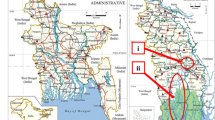Abstract
Growing population, human settlements, industrialization and intensification in groundwater-based cultivation have resulted in severe onslaught on underground aquifers in West Bengal, an eastern province of India with high population density. The present paper focuses on this water resource management issue. The study shows that traditional, village-level surface water reservoirs which for centuries had supplemented irrigation in addition to providing water for all sorts of domestic needs are now in doldrums. Through statistical analysis, the study shows that for all practical purposes, there is very little effective management of these precious open-access water resources. The situation calls for paradigm shift in policy on water resource management that entails development of community-based management catalyzed by government intervention, external agencies and NGOs under supervision and control of local elected bodies.


Similar content being viewed by others
References
Acharya, S. K. (2002). Arsenic contamination in ground water affecting major parts of Southern West Bengal and parts of Western Chhattisgarh: Source and mobilization process. Current Science, 82(6), 740–743.
Agricultural Census of India, Ministry of Agriculture, Govt. of India. (2002). Part-1 & 2 & www.indiastat.com (Datanet 2005).
Baland, J. M., & Platteau, J. P. (1996). Halting degradation of natural resources: Is there a role for rural communities?. Oxford, UK: Clarendon Press.
Bardhan, P. (2001). Water community: An empirical analysis of cooperation on Irrigation in South India. In M. Aoki, H. T. Takahashi, & Y. Hayami (Eds.), Communities and markets in economic development (p. 444).
Briscoe, J., & Malik, R. P. S. (2007). India’ water economy, an overview, In Hand book of water resources in India. New Delhi: Oxford University Press.
Calow, R. C., Rabins, N. S., Macdonald, A. M., Macdonald, D. M., Gibbs, B. R., Orpen, W. R. G., et al. (1997). Ground water management in drought prone areas of Africa. Water Research Development, 13(2), 241–261.
Carter, C., & Peter, H. (1994). Sustainable use of groundwater for small scale irrigation with special reference to sub-Saharan Africa. Land use Policy, 11(4), 275–285.
Census India. (2001). Government of India.
Goswami, A. B. (2002). Hydrological status of West Bengal. In S. R. Basu (Ed.), Changing environmental scenario of the Indian subcontinent (pp. 299–314). Calcutta: ACS.
GoTN. (2002). Department of Evaluation and Applied Research: Tamil Nadu—An Economic Appraisal 1999–2000. http://www.tn.gov.in/dear/ch5.pdf.
Hardin, G. (1968). The tragedy of the commons. Science, 162, 1243–1248.
Hayami, Y. (1997). Development economics: From the poverty to the wealth of the nation. Oxford, UK: Clarendon Press.
Irrigation Department Report. (2000).Govt. of West Bengal, India.
Kajisa, K. (2003). Collective management of local commons and its impact on household income: The case of tank irrigation in Tamil Nadu, India. India: Foundation for Advanced Studies on International Development.
Knight, J. (1992). Institutions and social conflict. Cambridge, UK: Cambridge University Press.
Kumar, R., Singh, R. D., & Sharma, K. D. (2005). Water resources of India. Current Science, 89(5), 794–811.
Loeve, R., Dong, B., Zhoa, J. H., Zhang, S. J., & Molden, D. (2001). Operation of Zhanghe irrigation system. In R. Barker, R. Loeve, Y. H. Li, & T. P. Tuong (Eds.), Water-saving irrigation for rice: Proceedings of an international workshop held in Wuhan China. Colombo, Sri Lanka: International Water Management Institute.
Moya, P., Hong, L., Dawe, D., & Chen, C. D. (2001).Comparative on-farm water-saving irrigation techniques in Zhanghe irrigation system. In R. Barker (Eds.). Proceedings of the international workshop on water-saving irrigation for paddy rice, March 2001, Wuhan, China
Ostrom, E. (1990) Governing the commons: The evolution for collective action. Cambridge, MA: Cambridge University Press.
Report of the Third Minor Irrigation Census. (2003). Ministry of water resources. Minor Irrigation Division, Government of India, New Delhi.
Rogers, P. (1992). Comprehensive water resource management—a concept paper. Washington, DC: World Bank.
Roy, M., Nilsson, L., & Pal, P. (2008). Development of groundwater resources in a region with high population density: A study of environmental sustainability. Environmental Sciences, 5(4), 251–267.
SANDEE. (2004). Policy brief: Tank degradation and poverty reduction- the importance of common property resources in sustaining the rural poor, no. 2, June. http://www.sandeeonline.org/publications/policybrief/policypaperbalu2004.pdf.
Shankari, U (1991). Tanks: Major problems in minor irrigation, economic and political weekly, 7–14 March, pp. 515–520.
Shen, L. (1994). Management of groundwater resources in China. Rome: FAO.
Walter, J. (1963). Tank systems of South India as flood moderator. Central Board of Irrigation and Power, 20(2), 87.
Wang, J., Xu, Z., Huang, J., Rozelle, S., Hussain, I., & Bilton, E. (2003). Water management reforms in the yellow river basin: Implications for water savings, farm incomes and poverty. http://www.iwmi.cgiar.org/propoor/files/ADB_Project/Research-Papers/.
Wester, P., Maranon, P. B., & Scott, C. A. (1999). Institutional responses to groundwater depletion: The aquifer management councils in state of Guanajuato, Mexico. Colombo, Sri Lanka: International Water Management Institute.
WIDD. (2004). Groundwater resources of West Bengal, Water Investigation and Development Department. Govt. of West Bengal.
Yang, Y., Watenabe, M., Zhang, X., Zhang, J., Wang, Q., & Hayashi, S. (2006). Optimizing irrigation management for wheat to reduce groundwater depletion in the piedmont region of the Taihang Mountains in the North China Plain. Agricultural Water Management, 82, 25–44.
Author information
Authors and Affiliations
Corresponding author
Additional information
Readers should send their comments on this paper to BhaskarNath@aol.com within 3 months of publication of this issue.
Rights and permissions
About this article
Cite this article
Roy, M. Managing the village-level open-access water resources in a region facing rapidly declining water availability. Environ Dev Sustain 12, 999–1012 (2010). https://doi.org/10.1007/s10668-010-9237-9
Received:
Accepted:
Published:
Issue Date:
DOI: https://doi.org/10.1007/s10668-010-9237-9




